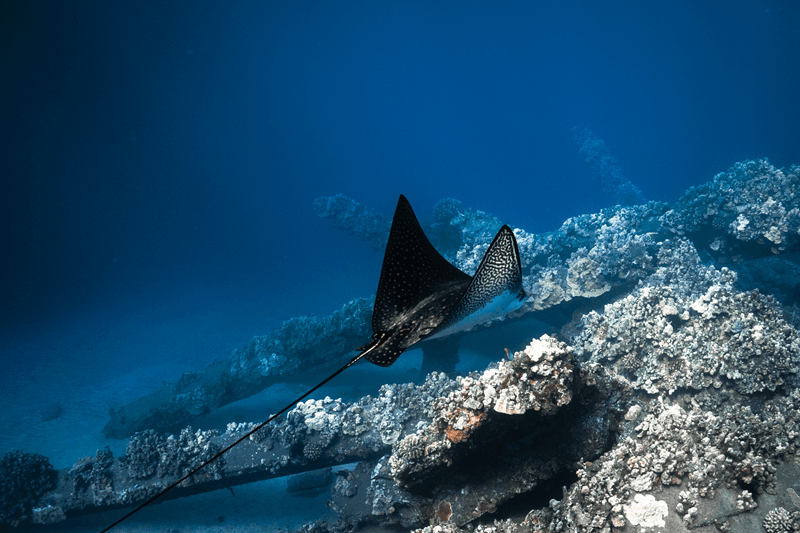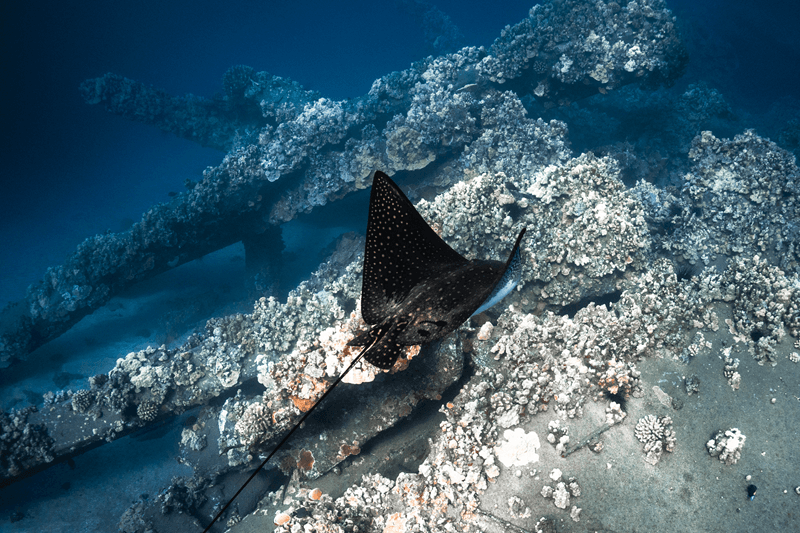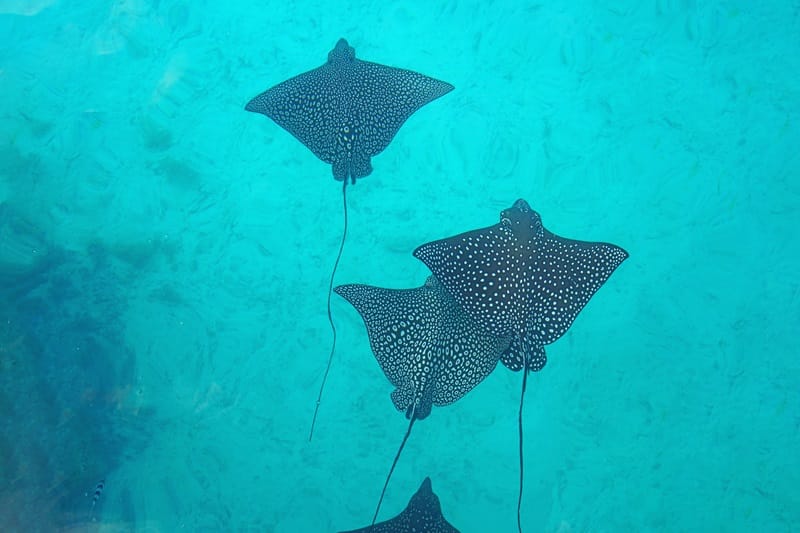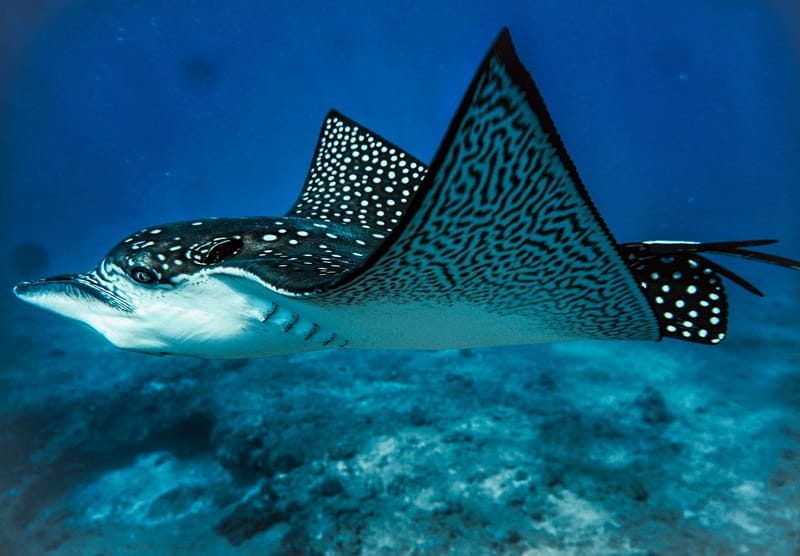Maui is renowned for its crystal-clear waters, vibrant coral reefs, and an impressive array of marine life. Of all the amazing animals in Maui’s waters, few impress snorkelers and divers like the spotted eagle ray. In Hawaiian, it’s called hihimanu, meaning ‘magnificent bird.’ With wide wings and graceful movements, it looks like it’s flying underwater. If you’re exploring Maui’s reefs, keep watch—you might spot one gliding by!
Seeing a spotted eagle ray in Maui is a moment you’ll never forget—a mix of wonder and awe. But these rays are more than just beautiful to watch. They have unique adaptations, fascinating behaviors, and play an important role in the ocean’s ecosystem. Let’s take a closer look at the hihimanu and see why it’s such a treasured sight in Maui’s waters.
An Introduction to the Spotted Eagle Ray
Hihimanu, which translates to “magnificent” or “elegant bird.” The name comes from their wide, wing-like fins, which let them glide under the ocean with both grace and power. In the open water, these rays seem to move effortlessly, captivating anyone lucky enough to witness them.
Spotted eagle rays are fish, but unlike most reef fish, they don’t have bones. Instead, their bodies are built from cartilage, like sharks. This makes them lighter and more flexible. It also connects them to their shark and ray relatives, who share special traits like electroreceptors and unique teeth.
Physical Characteristics and Coloration
One of the first things you’ll notice about a spotted eagle ray is its striking coloration. Their dorsal—or top—surface is typically a dark, inky black or charcoal gray background adorned with eye-catching white spots. This striking pattern makes them easy to recognize and also helps them hide from predators like sharks that might be looking down from above.
Flip the ray over, and you will see a vivid white underside. On each “wing,” a geometric pattern of black lines often appears against the brighter underbelly. Though you will need to observe them closely (perhaps while scuba diving or snorkeling), these intricate designs are breathtaking. It’s even more breathtaking when one suddenly leaps completely out of the water, show off its full size spotted beauty.
Spotted eagle rays (Aetobatus Narinari) possess large, angular “wings,” which are actually pectoral fins. Their wingspan can stretch to around six feet from tip to tip, making a close-up encounter unforgettable. Despite their size, they frequently appear to form large schools or travel solo, gracefully gliding through the water.
Additionally, these rays have a long whip-like tail, which often carries one or more barbed spines at its base. This detail can lead to confusion with other, more common stingrays. In Hawaiʻi, only three ray species are true ‘stingrays,’ with venomous spines farther down their tails.
Spotted eagle rays are different—their spines sit closer to the body. While the barbs can be painful if touched, these rays are shy around people and usually swim away when approached.
Molokini Crater Snorkeling
Experience the magic of Molokini Crater! Snorkel with vibrant fish and majestic sea turtles. Book your adventure today!
Where Do Spotted Eagle Rays Live?
Spotted eagle rays live in the Pacific Ocean, including the waters around Maui. They are also found in the Indo-Pacific and Atlantic Oceans. Beyond Hawaii, they inhabit tropical and warm temperate waters. They favor shallow coasts and reef areas, especially where the water is warm, clear, and full of their favorite prey. The Hawaiian Archipelago, with its extensive coral systems and relatively stable ocean temperatures, offers a hospitable habitat.
In Maui, hihimanu are often seen near reefs or sandy sea beds where they hunt for buried treats like clams and oysters. They sometimes swim into deeper water, but most are spotted gliding along the coast or visiting popular dive sites. Keep in mind that sightings are not guaranteed—they travel widely and can appear in large schools or cruise alone in small groups.
The Fascinating Senses
Like sharks and other rays, spotted eagle rays have special sensors called the ampullae of Lorenzini. These tiny pores sit around their snout and jaw. They use the ray to find weak electric fields from prey. This may also help them sense the Earth’s magnetic field for navigation.
Think of the ampullae of Lorenzini as a built-in metal detector. When small crustaceans hide in the sand, spotted eagle rays can still find them by detecting the tiny electric signals living creatures give off. They also have a lateral line system—a row of sensors along each side of their body. This helps them feel changes in water movement, so they can sense nearby fish, predators, or any motion in the water and react fast.
What’s on the Menu?
These rays are generally carnivorous, feeding on a variety of crustaceans and mollusks. They favor snails, shrimp, crabs, and sea urchins, all of which can often be found scuttling or burrowing in the sandy or rocky seafloor.
Their specialized mouths reveal flat, hard teeth plates—imagine a built-in nutcracker—that can crush the hard shells of their prey. Once these shells are shattered, the rays spit out the fragmented pieces and swallow the soft tissues inside.
Interestingly, male spotted eagle rays have teeth plates that are slightly more pointed than females. Researchers believe this distinction helps the male grip the female’s fin during mating. Since these rays need a strong grip to line up during mating, their unique teeth play an important role in their life cycle.
The Mating Ritual and Reproduction
Spotted eagle rays reach sexual maturity between four and six years of age. They reproduce through ovoviviparity, meaning embryos develop inside the mother, nourished by a yolk sac before birth.
During mating, the male uses his pointed teeth to grip the edge of the female’s wing and hold himself in place. The mating itself lasts about a minute, but the courtship often includes smooth swimming and even leaps out of the water.
Interestingly, spotted eagle rays display a form of reproduction known as ovoviviparity. The embryos grow in the female’s left uterus. They get nutrition from a special ‘uterine milk’ instead of an umbilical cord.
After a gestation period, a female typically gives birth to one to four pups. Each newborn ray measures between 10 and 20 inches across, its wings folded up like bats’. New mothers have been seen leaping out of the water and releasing their pups mid-air—literally giving birth on the fly.
Once born, the pups unfold their wings and start swimming right away. This skill is vital because predators like tiger sharks hunt young rays. From the start, they need to swim fast to survive.
Spotted Eagle Rays vs. True Stingrays
Even though the spotted eagle ray has a whip-like tail with barbed spines, it isn’t considered a true stingray in Hawaiʻi. In true Hawaiian stingrays, venomous spines line the tail much further down from the ray’s body.
Hawaiian eagle rays pose little threat to humans except in the rare instance that one is touched or stepped on. Because these creatures usually keep their distance when approached by snorkelers or divers, injuries are exceedingly rare.
Still, it’s wise to practice respectful ocean etiquette. If you spot a spotted eagle ray while snorkeling, give it space to swim freely. Enjoy watching spotted eagle rays from a safe distance. Don’t crowd or touch them—this keeps the ray calm and keeps you safe too.
Snorkel Maui
Discover Maui’s underwater wonders! Snorkel amidst vibrant coral reefs and encounter fascinating marine life. Book your Maui Snorkeling adventure today!
Where to Spot Eagle Rays in Maui
These rays can be found all throughout Maui, but here are a few of the more common spots:
Molokini Crater
A popular snorkeling and dive destination, Molokini Crater is situated a few miles off the coast of South Maui. This volcanic atoll has clear water. You can often see over 100 feet deep, making it one of the best spots to see marine life. Spotted eagle rays sometimes cruise along the outer ledges or near the crater’s reef walls.
Molokini Crater Snorkeling Tour
Embark on our daily Molokini Crater Snorkeling Tour departing from Ma’alaea Harbor! This two-stop adventure (7 am-12 pm) takes you to the crater and the renowned Turtle Town, Maui. Enjoy breakfast and lunch onboard, along with all the snorkeling gear you’ll need. Reserve your spot now and get ready to swim with vibrant tropical fish, graceful sea turtles, and possibly an eagle ray!
Turtle Town (Maluaka Beach)
Turtle Town in Makena is famous for its green sea turtles. You might also see a spotted eagle ray swimming by. The calm waters and gentle slope of the sea floor make it a comfortable place for these rays to forage. Early mornings, when the sun is less intense, can be a particularly good time for an encounter. Book your spot today for our morning tour to Turtle Town, Maui!
Olowalu Reef
Located along the West Maui coastline, Olowalu Reef is known for its expansive coral gardens and rich marine life. This shallow reef system offers a chance to observe spotted eagle rays gliding in search of food. The sandy areas between coral heads are prime feeding grounds for them as they probe the sand for crustaceans.
Kaʻanapali Beach and Black Rock
Kaʻanapali Beach is a popular resort area. However, early-morning snorkelers near Black Rock may see spotted eagle rays. Black Rock’s deeper drop-offs offer a corridor where rays sometimes patrol.
Honolua Bay
Northwest of Kapalua, Honolua Bay is a scenic marine preserve known for healthy reefs and diverse sea life. On a calm day, you might spot one passing through in small groups.
Best Time and Conditions for Sightings
Spotted eagle rays don’t follow a set season in Maui, but there are times when they show up more often. In general:
Early Mornings: Many sea animals are more active in the morning. The ocean is calmer then, and there are fewer boats and people.
Calm Seas: When the water is calmer, visibility tends to be better, making it easier to spot gliding rays.
High Tides: During higher tides, rays might move closer to shore to feed, though this is not guaranteed.
Signing up for our guided snorkel tours can also improve your chances of an encounter. We know the rays’ most frequent haunts and can optimize your outing around daily conditions. But remember, these are wild animals—no matter how prepared you are, sightings can never be completely guaranteed.
Threats and Conservation
Spotted eagle rays, while not as critically endangered as some marine species, still face a range of threats:
Predation by Sharks: Tiger sharks, in particular, are natural predators.
Fishing Pressure: Eagle rays occasionally get targeted for their oil or fishmeal, though they are not widely prized for their meat.
Bycatch and Entanglement: They can accidentally get caught in nets or fishing lines. This can cause serious injuries or even death.
Habitat Destruction: Coastal development, pollution, and coral reef damage can negatively affect their feeding grounds.
The IUCN Red List shows this ray’s conservation status, which highlights the need to monitor it. As with many marine species, balancing tourism and development with conservation is crucial. Spotted eagle rays thrive when reefs are protected through marine reserves, fishing rules, and responsible tourism.
Visitors to Maui can help protect amazing animals by joining our sustainable snorkeling tours or assisting with local cleanups.
The Cultural Significance of Hihimanu
For centuries, Hawaiians have respected marine life as more than a resource—it is part of their culture and tradition. The spotted eagle ray, or hihimanu, is seen as a symbol of grace and beauty. Its name means “magnificent” or “elegant bird.” This shows the awe people feel when they see one gliding through Hawaiian waters. Both locals and visitors often view these rays with reverence, as reminders of the ocean’s incredible diversity.
In Hawaiian tradition, some families see rays and other sea creatures as aumakua, or family guardians. Not every family has the spotted eagle ray as their aumakua. However, this idea shows deep respect for marine life and gives it spiritual meaning. It also creates a sense of kuleana—responsibility—to care for these animals and the ocean they live in.
Tips for a Respectful Encounter
Keep a Comfortable Distance: Getting too close can stress the ray. This may cause it to flee or change its behavior.
Do Not Touch: Although rays are docile, touching them can injure their sensitive skin or cause a defensive reaction.
Avoid Chasing: If you try to pursue or corner a ray, it can become agitated. Allow them space to move naturally in their habitat.
Minimize Splashing: Abrupt movements or loud splashes may startle marine animals.
Use Reef-Safe Sunscreen: Chemicals in regular sunscreens can harm coral reefs. These reefs are important for the rays’ ecosystem. Opt for mineral-based, reef-safe alternatives.
Part of the excitement of seeing a spotted eagle ray is the sense that you’re a guest in its domain. The calmer and more respectful you are, the better your chances of a meaningful observation.
Photographing Spotted Eagle Rays
If you’re keen on capturing a photo or video of the ray, consider these suggestions:
Slow, Steady Movements: Minimize your own motion in the water to reduce disturbance.
Buoyancy Control: Good buoyancy control helps you avoid hitting coral or the seafloor when scuba diving. It also prevents the rays from getting scared away.
Natural Light: When you snorkel in shallow water, sunlight shines through the surface, highlighting the rays’ spotted pattern.
Respectful Distance: Use zoom if possible rather than moving too close. Beyond ensuring the ray’s comfort, these practices can lead to clearer and more impressive shots.
Bringing the Experience Home
One of the best parts of snorkeling or diving in Maui is the chance to see marine life in its natural home. Many visitors say their first sight of a spotted eagle ray feels like time standing still, amazed by its smooth motion and grace.
It’s normal to share that moment with friends or on social media. But think about sharing a message about conservation too, showing how you help protect the ocean. Through storytelling and advocacy, each traveler can help inspire others to respect and protect Hawaii’s marine environments.
If you want to delve deeper, you might explore local conservation efforts or follow reef protection organizations in Hawaiʻi. By staying informed, you can help protect spotted eagle rays—whether you’re in Maui or at home.
Fun Facts
- Spotted eagle rays can live up to 8 years in the wild.
- Their black-and-white stripes and spots can fade or darken with light and mood.
- They thrive in both shallow tide pools and calm lagoons.
- They’re found across the Indo-Pacific and Atlantic, but Maui has some of the biggest schools.
- Even though they’re small compared to sharks, they’re some of the reef’s hardest workers.
Final Thoughts
Maui’s allure stretches far beyond its sunny beaches and lush mountains. Beneath the waves lies a world brimming with color, life, and wonder—none more mesmerizing than the spotted eagle ray. With its striking spots and unique feeding and mating habits, the spotted eagle ray captures the beauty and mystery of Hawaii’s ocean. Its Hawaiian name, hihimanu, shows the deep respect these islands hold for a creature that seems to both dance and fly beneath the waves.
A journey to Maui becomes richer when you learn about the creatures inhabiting its waters. When you choose responsible tours, follow marine life guidelines, and respect the cultural meaning of these animals, you make your own experience better—and help future generations enjoy the same amazing sights.
Whether you are a diver, a first-time snorkeler, or just curious, look for the white spots and gentle wingbeats of these rays. If you’re lucky enough to see one, take a moment to enjoy it. In that moment, you become part of a long story. It is about the harmony between Hawaiʻi’s people, their traditions, and the sea’s wonderful creatures.
‘Aʻohe hana nui ke alu ʻia—‘No task is too big when done together.’ By learning about Maui’s marine life, we can help protect the ocean. This also helps the graceful hihimanu that swim in it. May your meeting with a spotted eagle ray be as magical as the stories say. May that memory remind you of the ocean’s delicate beauty wherever you go. We look forward to welcoming you on our snorkeling tours!
Maui Snorkeling Tours
Dive into Maui’s crystal-clear waters and explore its vibrant coral reefs teeming with marine life. Our Maui Snorkeling Tours offer unforgettable experiences for all skill levels. Book your underwater adventure today and create memories that will last a lifetime!




